حدائق فاخرة للأطفال مصممة خصيصًا للعملاء المواطنين.
Background
Children’s Park in Narrow Areas and Sluggish Remodeling Projects
<Table > Status of Parks in Seoul
| Type of Park | Total | City Park | Natural Park | Other Park | ||||||||||
| Sum | Urban Natural Park | Living Area Park |
Theme Park |
|||||||||||
| Neighborhood Park | Children’s Park | Small Park | Sports Park | Cemetery Park | Culture Park | History Park | History Park | History Park | ||||||
| No. of Parks (Places) | 2,714 | 2,119 | 20 | 392 | 1297 | 346 | 4 | 4 | 39 | 11 | 5 | 1 | 1 | 594 |
| Area (㎢) | 169.12 | 115.94 | 65.56 | 44.06 | 2.22 | 0.46 | 0.13 | 2.42 | 0.59 | 0.44 | 0.04 | 0.05 | 39.35 | 15.84 |
<Figure 1> Area Developed for Children’s Parks
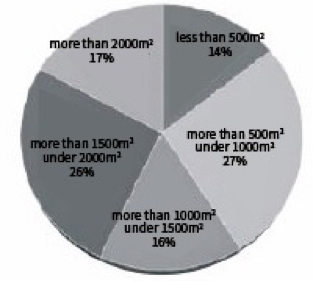
In order to improve the situation of the children’s parks, Seoul has facilitated children’s park renewal projects including ‘Creation of Resident Participation Children’s Parks,’ ‘Children’s Park Improvement Tailored to the Living Area,’ etc. since 1994 based on its ‘Modernizing Plan for the Children’s Parks.’ But the park remodeling projects in the beginning stage had focused on the appearance of facilities such as replacement of existing old facilities with modern ones and introduction of unusual shapes of playing facilities. As a result, the usage rate of children’s parks was still low because substantial improvement had not made and the management had been insufficient.
<Table 1 > Timeline of the Children’s Park Remodeling Project of Seoul
| Period | Description |
| Before 1994 |
|
| 1995~2005 |
|
| After 2005 |
|
Main Age Groups and Use Types of the Children’s Park
Low Satisfaction and Safety of Children’s Park Users
The number of child safety accidents increased from 146 in 2004 to 307 in 2006 (Korea Consumer Agency, 2008). The main causes were broken parts of timber or rust spots in the playing facilities. It implied that there were problems regarding facility safety. The users were more exposed to incidents because guidance facilities necessary for safety management were not installed in the parks or the regulations for safety prevention were not enough. In addition, less than half of the parks (49.6%) had signs or posts which contained information about the managing entities and only 24% of such notices had the contact information for the managing departments. It led to lower safety of the children’s parks.
According to the surveys, not only safety but also user satisfaction of the children’s parks was low. The main causes of low user satisfaction were the monotonous playing facilities and the insufficient subsidiary facilities. The users wished that the subsidiary facilities such as toilets, which showed the lowest satisfaction, drinking fountains and trash cans would be improved, and facilities for the disabled, the elderly, the infirm and children would be improved. Children wished that there would be sufficient playing facilities and floor pavement for safety. In addition to improving the facilities, the users wanted prevention of noise in the parks, no admittance of drunken people and pet management to ensure the safety of parks in the night time.
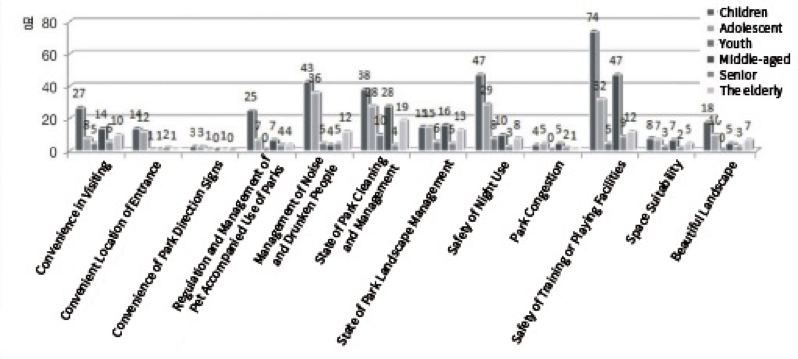
Progress
Expansion of the Concept of Fancy Children’s Park
In order to help the children use the playing facilities in safe and convenient ways and to establish an effective safety management system based on the act on safety management of playing facilities, Seoul integrated separated management of the children’s parks and the children’s playgrounds. Seoul planned to redevelop the existing children’s parks, but expanded the concept of fancy children’s park to cover the children’s playgrounds considering that 56% of Seoul’s population lived in the apartments and they used the playgrounds in the apartment complexes.
Selection of Project Places for Fancy Children’s Parks
The project to create fancy children’s parks for 304 children’s parks in 25 autonomous districts has been commenced. Based on the project plans, Seoul started to develop the existing simple and old children’s parks into “Theme Playing Parks” and “Regional Community Spaces” to be able to foster children’s dreams, creativity, and imaginations. In the process of park development, children and residents directly participated in the projects.
Development Strategy
Seoul established the following development strategy for the creation of fancy children’s parks;
As a part of this strategy, in particular, Seoul plans to have discussions with children through special classes in the schools and to invite parents to collect their opinions.
For design, Seoul holds design workshops and expands the possibilities for civil participation via the introduction of a citizen and customer supervising system.
With an aim to create pleasant and safe parks, Seoul has to use eco-friendly materials. When installing sand playgrounds, safety from dog ascaris and heavy metal pollution will be considered.
Themes shall be assigned to the park designs and the park designs shall be made in accordance with these unified themes.
Budget for the Fancy Children’s Park Project
During the project period from 2008 to 2010, Seoul redeveloped 304 places, a fourth of the 1,278 places in total by investing KRW 147.2 billion (KRW 100.1 billion from the Seoul Metropolitan Government and KRW 47.1 billion from the autonomous districts).
Implementation of Fancy Children’s Park Project
The old children’s parks were redeveloped to become fancy children’s parks during a period of about 3 years from March 2008 to May 2011. According to the “Child Playground Facilities Safety Supervision Law” enacted on January 27th, 2008, the parks were redeveloped to put top priority on the safety of children.<Figure 3> Process of the Fancy Children’s Park Redevelopment Project
| Idea contests for citizens & customers and college students | è | Design Contest for the pilot models | è | Selection of excellent designs (design companies) | è |
| Basic plans (drafts) | è | The 1st presentation to residents | è | Adjustment of plans (drafts) after the 1st PT for residents | è |
| The 2nd design workshop | è | Plans (drafts) made via resident participation design process | è | Review and deliberation with the autonomous districts | è |
| Reflection of deliberation results to the plans (drafts) | è | Order | è | Implementation of construction |
Establishment of Plan for Children’s Park Improvement Project
Decision of Names and Status Investigation of the Target Places
In October 2007, Seoul held the investment assessment for the fancy children’s park project, established the general improvement plan for the children’s parks and decided the project name to be “Fancy Children’s Parks Tailored for Citizen Customers”. It also investigated the target locations for the project in the 25 autonomous districts.Formation of Advisory Committee
In February 2008, Seoul formed an advisory committee for the implementation of fancy children’s park project and investigated if the project is contradictory to the urban development project in order to select the target locations for the children’s park project.
Idea Contest for Citizen Customers and College Students
Prize Contest for the Pilot Model
Seoul selected 10 representative locations for the contest through the advisory committee meetings for site selection.
Selection of Excellent Designs (Design Companies)
Basic Plan (Draft)
Based on the pilot models, the design companies established their basic plans for 20 locations.
1st Presentation to Residents
Seoul held presentation sessions for the local residents. The events were held for children in grades 4 to 6 in primary schools as a part of inquiry instructions in social studies. The children presented their opinions in the forms of pictures and texts using the titles “Playground that I want to make” and “Please make our parks in this way,” The experts announced the basic plans (drafts) to children and residents to collect their responses and opinions on the experts’ plans.
<Figure 4> The 1st Presentation for Residents and Children’s Opinions

The 2nd Design Workshop
The adjusted plans (drafts) made based on the opinions raised in the presentation sessions were explained during the design workshop held in the children’s parks.
<Figure 5> The 2nd Design Workshop

Plans (Drafts) Made via Resident Participation Design Process
The plans (drafts) were adjusted again in consideration of the acceptable opinions among the ones that were suggested by children and residents through their participation.
Review and Deliberation with the Autonomous Districts
The autonomous districts reviewed the plans (drafts) established through the resident participation design process to create the agenda and to calculate the necessary budget. The expert advisory committee, the Urban Public Park committee and the Korea Community Safety Testing Institute deliberated about the creativity of facilities, space construction, and relevant regulations.
Reflection of the Deliberation Results to the Plans (Drafts)
The final designs (drafts) were decided by considering the opinions suggested through the review and deliberation with the autonomous districts.
Order and Implementation of Construction
Orders were placed for the implementation of construction. The representative residents, the supervisors from the Seoul Metropolitan Facilities Management Corporation and the construction advisory committee members participated in the enforcement of construction.
Effects
Results of the Fancy Children’s Park Project
| Name of Autonomous District | No. of Children’s Parks | Fancy Children’s Parks | Name of Autonomous District | No. of Children’s Parks | Fancy Children’s Parks |
| Jongno | 24 | 3 | Mapo | 55 | 13 |
| Jung-gu | 22 | 1 | Yangcheon | 71 | 12 |
| Yongsan | 32 | 3 | Gangseo | 125 | 20 |
| Seongdong | 33 | 8 | Guro | 25 | 11 |
| Gwangjin | 35 | 15 | Geumcheon | 41 | 13 |
| Dongdaemun | 52 | 4 | Yeongdeungpo | 32 | 4 |
| Jungnang | 44 | 21 | Dongjak | 34 | 8 |
| Seongbuk | 36 | 6 | Gwanak | 70 | 25 |
| Gangbuk | 40 | 9 | Seocho | 84 | 4 |
| Dobong | 39 | 24 | Gangnam | 61 | 6 |
| Nowon | 92 | 36 | Songpa | 82 | 13 |
| Eunpyeong | 47 | 16 | Gangdong | 64 | 19 |
| Seodaemun | 44 | 10 | Total | 1,284 | 304 |
<Figure 6> Kkachi Fancy Children’s Park -Exciting Space Travel |
<Figure 7> Seockchon Fancy Children’s Park – Adventures of Robinson Crusoe |
<Figure 8> Boram Fancy Children’s Park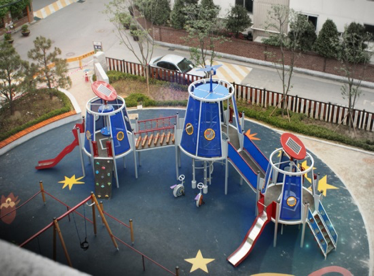 |
<Figure 9> Hagye Fancy Children’s Park – Playground of Fairy in the Forest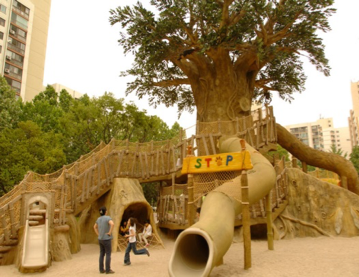 |
<Figure 10> Siny Fancy Children’s Park – Smurf Village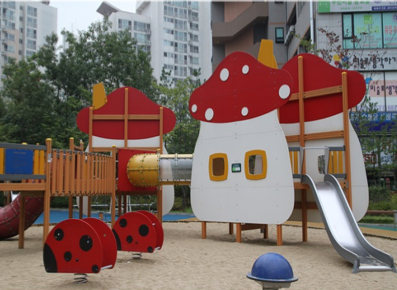 |
<Figure 11> Hodori Fancy Children’s Park – Concentric Circles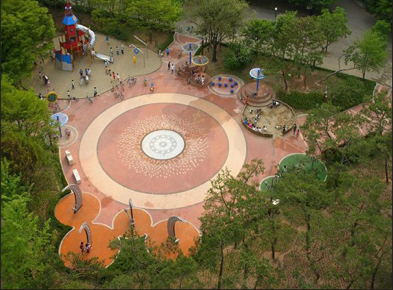 |
Evaluation
References
Won-ju Kim, 2009, “Children’s Park Improvement Strategy to Induce Imagination and Creativity”, Seoul Development Institute
Won-ju Kim, 2008, “A Study on How to Improve the Children’s Park through the Users’ Evaluation”, the Seoul Institute